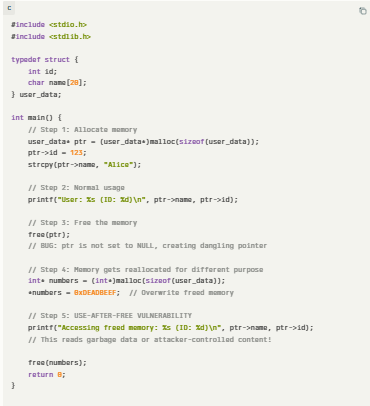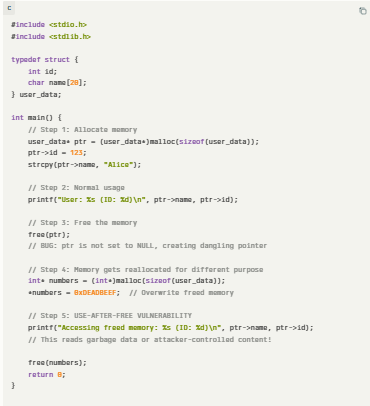Use-after-free (UAF) vulnerabilities represent one of the most critical and prevalent security threats in modern software systems, particularly affecting applications written in memory-unsafe languages like C and C++.
These vulnerabilities occur when a program continues to use a memory location after it has been freed, creating opportunities for attackers to manipulate program execution flow, corrupt data, or achieve arbitrary code execution.
The severity of use-after-free vulnerabilities is underscored by their frequent appearance in high-profile security advisories and their exploitation in real-world attacks against web browsers, operating systems, and critical infrastructure software.
How Use-After-Free Vulnerability Occurs
Use-after-free vulnerabilities emerge from fundamental flaws in memory management practices within applications that manually handle dynamic memory allocation and deallocation.
The vulnerability manifests when a program deallocates a memory region using functions like free() in C or delete in C++, but subsequently attempts to access or manipulate the same memory location through dangling pointers.
This creates a dangerous condition where the freed memory may have been reallocated for different purposes, leading to unpredictable program behavior.
The following concise C code demonstrates the core mechanism of a use-after-free vulnerability:

The technical mechanics of use-after-free vulnerabilities involve several critical stages in the memory lifecycle. Initially, a program allocates memory dynamically using allocation functions such as malloc(), calloc(), or the new operator, creating a valid pointer to a memory region.
During normal execution, the program may legitimately free this memory using free() or delete, marking the memory region as available for reuse by the memory allocator.
However, if the program fails to set the pointer to NULL after freeing the memory, or if multiple pointers reference the same memory location, subsequent access attempts create use-after-free conditions.
The vulnerability becomes particularly dangerous when the freed memory is reallocated for different data structures or objects with varying layouts and purposes.
Modern memory allocators often reuse freed memory blocks quickly to optimize performance, meaning that a use-after-free access might interact with completely different data than originally intended.
This memory reuse can lead to type confusion vulnerabilities, where the program interprets data of one type as another, potentially allowing attackers to manipulate object properties, function pointers, or other critical program state.
Common programming patterns that introduce use-after-free vulnerabilities include improper cleanup in object destructors, race conditions in multithreaded applications, and complex object lifetime management in callback-heavy architectures.
Web browsers, which manage numerous objects with intricate relationships and event-driven lifecycles, are particularly susceptible to these vulnerabilities due to their complex JavaScript engines and DOM manipulation capabilities.
Exploiting Use-After-Free Vulnerability
The exploitation of use-after-free vulnerabilities requires sophisticated techniques that leverage the predictable behavior of memory allocators and the specific memory layout patterns of target applications.
Attackers typically employ a multi-stage approach that begins with triggering the vulnerability through carefully crafted input or interaction sequences, followed by precise memory manipulation to achieve desired exploitation outcomes.
The following concise C code demonstrates the core mechanism of a use-after-free vulnerability:

Heap Spraying and Memory Layout Control represents the foundational technique in use-after-free exploitation. Attackers first trigger the freeing of a target object, then immediately allocate numerous objects of the same size to increase the probability that one of their controlled objects occupies the freed memory location.
This technique, known as heap spraying, allows attackers to replace the freed object with malicious data structures containing crafted function pointers, object properties, or other exploitable elements.
Real-world exploitation examples demonstrate the severity of these vulnerabilities. In 2019, researchers discovered CVE-2019-5786, a use-after-free vulnerability in Google Chrome FileReader implementation that affected millions of users worldwide.
The vulnerability occurred when JavaScript code triggered the destruction of FileReader objects while asynchronous file operations were still pending, creating a window where freed memory could be accessed during callback execution.
Attackers exploited this vulnerability by carefully timing JavaScript execution to control the freed memory contents, ultimately achieving arbitrary code execution within the browser’s renderer process.
Advanced exploitation techniques involve Return-Oriented Programming (ROP) and Jump-Oriented Programming (JOP) to bypass modern security mitigations like Data Execution Prevention (DEP) and Address Space Layout Randomization (ASLR).
Attackers leverage use-after-free vulnerabilities to overwrite function pointers or virtual function tables, redirecting program execution to carefully chosen instruction sequences that perform attacker-controlled operations without requiring executable memory regions.
The Pointer Authentication Bypass technique has emerged as attackers adapt to newer processor security features.
On systems with pointer authentication capabilities, attackers use use-after-free vulnerabilities to leak authentic pointer values, then reuse these authenticated pointers in subsequent exploitation stages to bypass pointer integrity checks.
Mitigating Use-After-Free Vulnerability
Comprehensive mitigation of use-after-free vulnerabilities requires a multi-layered approach combining secure coding practices, automated detection tools, and runtime protection mechanisms.
The most effective strategies address vulnerabilities at multiple stages of the software development lifecycle, from initial design through deployment and maintenance.
The following table provides a comprehensive overview of mitigation techniques categorized by their implementation approach and effectiveness:
| Mitigation Category | Technique | Description | Implementation Phase | Effectiveness | Performance Impact |
|---|---|---|---|---|---|
| Static Analysis | Code Review | Manual examination of code for memory management flaws | Development | Medium | None |
| Static Analysis | Static Analysis Tools | Automated source code scanning (Clang Static Analyzer, PVS-Studio) | Development | High | None |
| Dynamic Analysis | AddressSanitizer (ASan) | Runtime memory error detection with immediate crash on UAF | Testing/Debug | Very High | High (2-3x slowdown) |
| Dynamic Analysis | Valgrind Memcheck | Comprehensive memory error detection during testing | Testing | High | Very High (10-50x slowdown) |
| Dynamic Analysis | Hardware-Assisted Sanitizers | Intel MPX, ARM Memory Tagging for runtime detection | Runtime | High | Low-Medium |
| Language Solutions | Memory-Safe Languages | Rust, Go, Swift with ownership/borrowing systems | Design | Very High | None to Low |
| Language Solutions | Managed Languages | Java, C#, Python with garbage collection | Design | Very High | Variable |
| Runtime Protection | Control Flow Integrity (CFI) | Prevents hijacking of corrupted function pointers | Runtime | Medium-High | Low |
| Runtime Protection | Pointer Authentication | ARM/Intel hardware pointer signing | Runtime | High | Very Low |
| Runtime Protection | Stack Canaries | Detection of stack-based corruption | Runtime | Low (UAF specific) | Very Low |
| Coding Practices | Pointer Nullification | Setting pointers to NULL after free() | Development | Medium | None |
| Coding Practices | Reference Counting | Smart pointers and automated lifetime management | Development | High | Low |
| Coding Practices | Object Ownership Models | Clear ownership hierarchies and RAII patterns | Design/Development | High | None |
| Allocator-Based | Debug Allocators | Allocators that detect use-after-free (Debug CRT, Guard Malloc) | Testing/Debug | High | High |
| Allocator-Based | Hardened Allocators | Production allocators with UAF detection (Scudo, PartitionAlloc) | Runtime | Medium-High | Low-Medium |
Memory Safety Tools and Static Analysis provide the first line of defense against use-after-free vulnerabilities. AddressSanitizer (ASan), a runtime error detector integrated into major compiler toolchains, instruments memory allocation and deallocation operations to detect use-after-free conditions immediately upon occurrence.
When ASan detects a use-after-free access, it terminates the program and provides detailed diagnostic information, including stack traces for both the original allocation and the erroneous access attempt.
Dynamic analysis tools like Valgrind’s Memcheck offer comprehensive memory error detection capabilities during testing phases, identifying not only use-after-free vulnerabilities but also related issues such as memory leaks and buffer overflows.
These tools employ shadow memory techniques to track the state of every allocated byte, enabling precise detection of improper memory access patterns.
Language-Level Mitigations represent a fundamental approach to eliminating entire classes of memory safety vulnerabilities. Modern programming languages like Rust enforce memory safety through ownership systems and borrow checking, making use-after-free vulnerabilities impossible to introduce through normal language constructs.
Similarly, managed languages like Java and C# eliminate manual memory management entirely, relying on garbage collection to prevent premature memory deallocation.
Runtime Protection Mechanisms provide additional security layers for applications that must continue using memory-unsafe languages. Control Flow Integrity (CFI) prevents attackers from hijacking program control flow through corrupted function pointers, significantly reducing the impact of successful use-after-free exploits.
Hardware-assisted solutions like Intel’s Control-flow Enforcement Technology (CET) and ARM’s Pointer Authentication provide processor-level protections against common exploitation techniques.
Secure Coding Practices remain essential for preventing use-after-free vulnerabilities in existing codebases. These practices include immediately setting pointers to NULL after freeing memory, implementing reference counting systems for shared objects, and designing clear object ownership models that prevent ambiguous lifetime management. Code review processes should specifically focus on memory management patterns, particularly in complex scenarios involving callbacks, event handlers, and multithreaded access.
Use-after-free vulnerabilities continue to pose significant security risks to modern software systems, requiring comprehensive mitigation strategies that combine technological solutions with disciplined development practices.
While automated detection tools and runtime protections provide valuable safeguards, the fundamental solution lies in transitioning to memory-safe programming languages and architectures.
Organizations maintaining legacy codebases must implement rigorous testing regimens, deploy runtime protection mechanisms, and maintain continuous vigilance against these persistent and evolving threats.
The ongoing arms race between attackers developing sophisticated exploitation techniques and defenders implementing advanced mitigations underscores the critical importance of proactive security measures throughout the software development lifecycle.
Find this Story Interesting! Follow us on LinkedIn and X to Get More Instant Updates.
